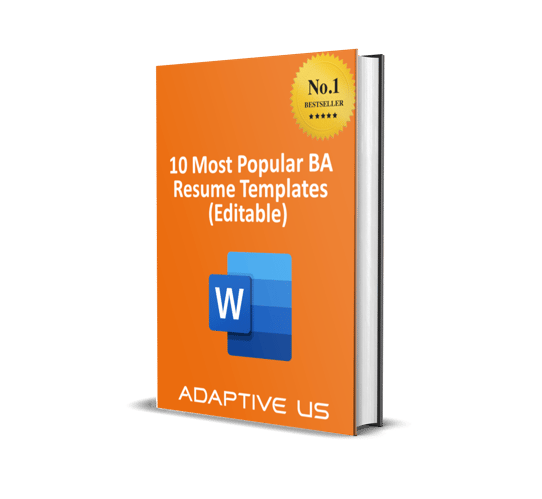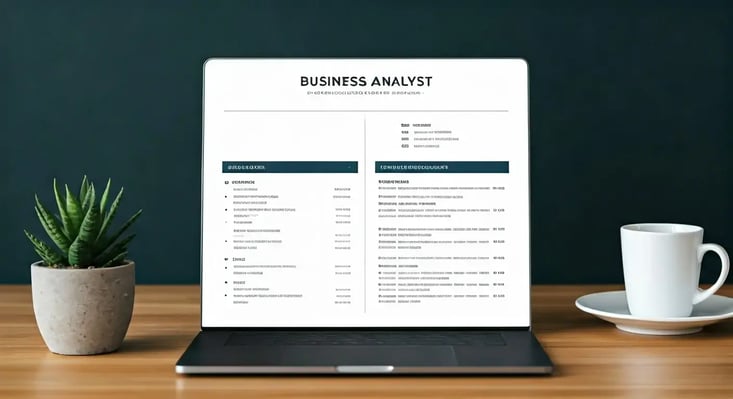20 Business Analyst Resume Tips for Your Dream Job

Key Highlights
- Learn how to tailor your business analyst resume to match specific job descriptions for impactful applications.
- Discover the importance of showcasing measurable achievements and highlighting unique technical skills.
- Understand why relevant industry certifications can elevate your resume and help you stand out as a Certified Business Analysis Professional(CBAP).
- Find strategies for streamlining your skills section while presenting work experience that resonates with hiring managers.
- Explore creative structuring techniques, such as choosing an ATS-friendly resume format and selecting concise bullet points for clarity.
This blog unpacks expert tips on optimizing your resume for business analyst positions and highlights ways to create a lasting impression.
Introduction
Are you ready to get your dream business analyst job? Creating the perfect IT business analyst resume is more than just writing down your work experience. You need to match your resume with the job description and use a clear resume template that reflects your desired job title. This way, you can catch the attention of hiring managers. A well-organized resume should show your skills in business analysis and what makes you unique. Whether it’s strong data analysis or project management that focuses on stakeholders, your resume must highlight how you can improve business processes and help with growth. To help you visualize this, let’s explore an effective resume example and the best ways to create a winning resume.

20 Essential Tips for Crafting a Business Analyst Resume
Making a great business analyst resume is all about being strategic and careful. You need to highlight key skills such as problem-solving and data analytics. You also have to use the right tone for project management. There are two important points for a strong resume: understanding business requirements and showing measurable business impact. If you follow the tips in this guide, your resume will catch the eye of hiring managers. It will also show how your work experience leads to operational efficiency and business success.
Now, let's look at 20 practical tips that can help your resume stand out from the rest.
Tip 1: Tailor your resume to the job description
Customizing your resume helps hiring managers see why you are a great fit for a business analyst role. Start by finding keywords and needs from the job description. Look for things like skills in business processes or experience with business analysis tools. Add these to your resume template to show you match the role.
Do not use the same old resume that does not meet the needs of the job. For example, if the job needs skills in data visualization, be sure to mention tools like Tableau or Looker in your skills section and work experience.
Changing the format of your resume to fit the company’s needs makes a strong case for your fit. Every part of your resume, from the skills section to project details or the resume summary, should change based on the business analyst job description you’re looking at. Keep in mind that being specific is usually better than being general.
Tip 2: Highlight your analytical skills
Your analytical skills as a data analyst are key. Show that you can interpret data and suggest real solutions. As a business analyst, mention projects where data analysis helped achieve clear improvements. For example, share achievements like “increased efficiency by 10% using insights from data.”
To highlight these skills, think about using bullet points that show your talent in handling large datasets, finding trends, and improving business processes. Make sure to list tools like Python, R, SQL, and Excel in your technical skills.
Also, explain how your analysis made a difference. Did it boost operational efficiency or raise customer satisfaction? Be clear and specific. Keep in mind that hiring managers appreciate business analysts who turn complex data into actionable plans and provide clarity to team members and stakeholders.
Tip 3: Include specific business analysis tools and technologies
Showcasing your skills in business analysis tools and technologies helps hiring managers trust your technical skills. You should include tools like Tableau, SQL, Looker, and other software that are key to today’s data analytics processes.
For example, explain how you used SQL to make queries faster, cutting execution times by 49%. You could also mention how you used Tableau for data visualization which helped in making better business impact decisions. This kind of detail shows you know your stuff and focus on getting good results.
Also, share examples where these tools improved operations or clarified business requirements. This could be through making reporting systems easier or working with teams to integrate software. These abilities will strengthen your resume template. Always try to include numbers when you can. Keep in mind, details about technologies not only show your skills but also prove you are ready to tackle business problems through innovation.
Tip 4: Showcase your problem-solving capabilities
As a business analyst, companies appreciate your skill in solving problems and finding ways to make things work better. Highlighting your problem-solving skills can make you stand out. Use examples from your work history where your actions led to real benefits, like fixing issues that saved money.
In your skills section, use words like “solved,” “addressed,” or “streamlined” to show that you take action. Make sure to explain any improvements you made, like cutting down downtime or increasing satisfaction scores.
Stay focused on your message: you don't just find problems; you create clear steps that help growth. Share projects where you worked with team members to come up with new ideas. This way, leadership will notice your ability to improve specific business processes effectively.
Tip 5: Detail your project management experience
Effective project management is very important in business analysis. It shows how you can organize, lead, and get results. Talk about big projects that included risk management or improving business processes. For instance, you might mention how you implemented a workflow that reduced project timelines by 12%.
Also, include your technical skills in managing teams that come from different areas. This shows you can adapt and lead. Knowing software like Microsoft Visio and tools for progress tracking can make your resume stand out.
In these roles, you likely focused on meeting deadlines and sharing ideas that improved business requirements. This is a crucial skill for a business analyst. In the end, show how you can manage complex projects and turn data into active, practical plans.
Tip 6: Emphasize your communication skills
Articulating ideas well is key for success as a business analyst. Show your communication skills by helping different team members work together. This includes both tech people and non-technical stakeholders.
You can share examples where you led workshops or gave presentations. Turn business intelligence ideas into formats that stakeholders can easily understand. When you talk about taking part in discussions with decision-makers, it shows your ability to build relationships.
Also, use phrases like “reported actionable findings” or “led stakeholder engagement” in your bullet points. These terms display your skill in simplifying complex business requirements. This helps different teams work clearly on tasks. Lastly, focusing on collaboration means you understand stakeholder needs. You also address concerns and help align the team to reach shared business goals.
Tip 7: Mention any relevant certifications
Highlighting the right certifications can make your resume stand out. Certifications like Certified Business Analysis Professional (CBAP) or Agile Certified Practitioner (ACP) show that you care about business analysis. They also prove that you have important skills recognized in the industry. This helps build trust in your skills, especially in data analysis and stakeholder management. Adding these certifications to your resume's education section or skills section can catch the eye of hiring managers. It highlights your qualifications for the business analyst role.
Tip 8: Demonstrate your ability to work with cross-functional teams
Collaboration with different teams is important for a successful business analyst. When you share your experiences of working with various groups, it shows your skills in managing stakeholders and building communication. This is key for getting business processes on the same page. For example, you can mention projects that required teamwork from different departments or times you took part in user acceptance testing. These examples show how flexible and strong you are as a leader. Focusing on this teamwork not only makes your resume better but also shows you can improve operational efficiency and help find good solutions in complicated situations.
Tip 9: Include achievements with measurable outcomes
Highlighting your achievements with clear numbers can greatly improve your resume. Hiring managers like data-driven results that give meaning to what you have accomplished. Instead of using unclear statements, show your success with numbers. For example, say you raised operational efficiency by 25% or helped save $50,000 in a certain project. These clear figures prove your skills and match the key performance indicators that are often important in business analysis jobs. Measurable outcomes clearly show your ability to provide actionable insights in the business world.
Tip 10: Use strong action verbs
Using strong action verbs can greatly improve your business analyst resume. These verbs catch the reader’s attention and show that you are proactive and have achieved a lot. Instead of saying "responsible for," you should use active words like "spearheaded," "optimized," or "facilitated." These words show that you can create change and lead projects well. Using lively and strong verbs makes basic descriptions more engaging. They highlight your role in business processes and teamwork. Keep in mind that every word matters in showing your unique professional path.
Tip 11: Incorporate keywords from the business analyst industry
A good resume should have keywords that hiring managers look for in the healthcare business analyst field. Focus on words like “data analysis,” “stakeholder management,” and “business processes.” These terms show that you fit the job description. Using the right language also shows you know the industry well. This can help your resume get through Applicant Tracking Systems (ATS). Make sure to also use words that match the skills needed in the healthcare business analyst role. This highlights your skills and makes your application stronger.
Tip 12: Highlight your educational background
A strong education is important for showing you are qualified as a business analysis professional. Focus on degrees that relate to business analysis, like business administration or data science. Make sure to mention any key courses that show your skills. If you have any certifications, such as the Certified Business Analysis Professional (CBAP), add these to the education section to boost your credibility. This will show your strong knowledge and help you stand out to hiring managers who want people with a solid education in business operations and data analytics.
Tip 13: Mention any training or workshops
Including useful training and workshops can greatly improve your attractiveness as a business analysis professional. These certifications show that you are serious about learning more. They also highlight your skills in certain methods, tools, and techniques related to the field. Hiring managers like candidates who can adapt and have current knowledge of best practices. This section of your resume should show any significant sessions you attended. Make sure to focus on how these experiences helped you grow in data analysis, project management, and working with stakeholders. This can lead to better operational efficiency.
Tip 14: Showcase your technical proficiency
To stand out as a business analyst, showing your technical skills is very important. You should include relevant software tools in business analysis, like project management tools and data visualization tools. Also, mention any programming languages or database management systems you know because they are key in today’s data-focused world. Talk about your experience with user acceptance testing and data analytics. These skills show that you can provide actionable insights and help improve operational efficiency. Not only does this strengthen your expertise, but it also meets what hiring managers expect.
Tip 15: Detail your experience with data analysis and reporting
Showing your experience with data analysis and reporting is very important for your business analyst resume. Mention specific projects where you used data visualization or did statistical analysis. This can highlight your skills in turning data into useful insights. Include numbers that show your impact, like improvements in operational efficiency or customer satisfaction. By talking about the software tools and methods you used, you give hiring managers proof of your skills in making decisions based on data. This way, you can show both your technical skills and your ability to produce good results through careful data analysis.
Tip 16: Include client testimonials if available
Using client testimonials is a strong way to show that you are effective in past business analyst roles. Positive feedback from clients or stakeholders can highlight your skills in understanding business requirements. This can make your profile more credible. It's important to have these testimonials focus on specific successes. This could be things like cost savings or better operational efficiency. Adding this type of real-life support to your business analyst resume gives more depth to your professional experience. It also helps to reassure hiring managers that you can provide actionable insights and improve customer satisfaction.
Tip 17: Provide examples of cost-saving initiatives
Detailing examples of cost-saving efforts can really boost your business analyst resume. By showcasing specific projects where you made process improvements or improved business operations, you show that you can drive operational efficiency. Showing how you helped achieve cost reduction, like streamlining workflows or managing resources better, proves your analytical skills to hiring managers. Including clear results, like the percentage of savings or cuts to budgets, adds a powerful touch to your work experience section. This really shows your ability to make a real difference in a company’s success.
Tip 18: List leadership roles in projects
Highlighting leadership roles in projects can really boost your business analyst resume. These roles show that you can lead different teams and handle complicated business needs. Share your experiences as a project leader. Focus on how you helped with project management and process improvement.
Use bullet points to outline your role clearly. Stress the results of your leadership, like better operational efficiency or higher customer satisfaction. This not only shows your soft skills but also makes you look like an experienced business analyst who can deliver great results.
Tip 19: Include any awards or recognitions
Including awards or recognitions in your business analyst resume can greatly boost your professional image. These awards show your skills and dedication to doing great work in business analysis. For example, mentioning achievements like "Certified Business Analysis Professional" or awards for excellent project management points out your commitment and ability to provide actionable insights. Make sure to put these awards in the awards section of your resume. This can help catch the eye of hiring managers and showcase your top-notch skills in the business analyst field.
Tip 20: Be concise and clear with your career objective
A clear career objective explains your job goals and connects them with the business analyst position. Being clear is very important; stay away from complicated words and focus on key skills like data analysis and project management. This part of your resume should show the value you bring, showing how you can improve business processes and help your team succeed. Hiring managers like a direct approach, which can boost your chances of leaving a strong impression.

How to Structure Your Business Analyst Resume
A well-organized business analyst resume is important to get noticed by hiring managers. Start with a clear layout. Make sure to show your professional experience section. Include your relevant work history and specific hard skills for the business analyst role. The education section should show your academic qualifications. The skills section must include both technical and soft skills for the field. Also, make sure each section flows well. This will help recruiters easily see your key accomplishments, certifications, and projects you were involved in.
Choosing the right resume format
Choosing the best resume format can really make a difference to hiring managers. A chronological format shows your career growth and is great for experienced professionals. On the other hand, a functional format focuses on your skills and abilities. This format works well for people who have different experiences or gaps in their work history. A hybrid format combines both styles. This way, you can show your work history while highlighting important skills for a business analyst role. Make sure you tailor the format to match the job description. This will help it connect with what the employer is looking for and show off your qualifications effectively.
Deciding on the length of your resume
Finding the best length for your resume is very important for making a good impression on hiring managers. For junior business analysts, one page is usually enough. For experienced professionals, it can be two pages to highlight their work history and relevant skills. Each section of your resume should be clear and direct, focusing on key skills and experiences that match the job description. It's important to present your achievements in business analysis and project management in a way that is easy to read. Aim to be concise while showing your qualifications clearly and powerfully.
Enhancing Your Resume’s Visual Appeal

A good-looking resume makes it easier to read and grabs the attention of hiring managers. It's important to pick the right fonts and sizes. This gives your resume a clean and professional feel, showing that you pay attention to details. You can also use bullet points to break down complicated information. This makes it easier to understand your qualifications and work experience.
Adding white space helps create a nice layout. It makes sure every section is clear. Keep in mind that the design should support the content. It should not overshadow your skills and achievements. Let them be the focal point of your resume.
Selecting appropriate fonts and sizes
Choosing the right fonts and sizes can really help make your business analyst resume easier to read. Pick professional and clean fonts like Arial or Calibri. These fonts match what companies expect. Use a font size between 10 and 12 points for the main text. This ensures clarity. For headings, you can use a slightly larger size, around 12 to 14 points. This helps create a clear structure. Keeping the spacing and line heights consistent makes your resume look better. This way, hiring managers can easily find your work experience and skills section. It helps show your qualifications in the best way.
Using bullet points effectively
Using bullet points well can change your business analyst resume into a strong story that grabs the attention of hiring managers. Start each bullet with a powerful action verb to highlight your achievements in business analysis and project management. Clearly list tasks, like stakeholder management or data analysis, to improve your work experience section. Keep your points short and clear so that your key skills and relevant skills stand out. This organized method helps show your contributions, making your resume simple to read and effective.
Advanced Techniques for Resume Optimization

Incorporating ATS-friendly keywords is important for standing out in applicant tracking systems. Tailoring your business analyst resume with the right industry terms helps hiring managers see how you fit the role. Using lively language to describe your impact shows your work in business analysis and project management. Highlighting your achievements by focusing on results and operational efficiency will catch attention. Avoiding passive phrases will strengthen your authority in data analysis, making it easier for you to reach your desired position.
Leveraging ATS-friendly keywords
Including ATS-friendly keywords in your resume is very important. This helps it get through automated screenings. Looking at job descriptions shows the words hiring managers want to see. These words include "business analysis," "stakeholder management," and "data analysis." Adding these keywords to your resume makes it stand out and shows you are a good fit for the business analyst role. Using strong language in the experience section can highlight your important work. This could be cost savings projects or successful project management. By using these keywords effectively, you can improve your chances of getting that dream job.
Utilizing dynamic language to showcase your role impact
Using lively language can greatly improve your business analyst resume. When you add strong action words and clear numbers, you tell a story about your contributions. For example, instead of saying you "worked on" a project, use phrases like "spearheaded a cross-functional initiative that led to a 20% increase in operational efficiency." This way, you highlight your role and link your actions to clear results. This makes your experience more interesting to hiring managers who look for measurable outcomes in data analysis and process improvement.
Conclusion
To make a good business analyst resume, you need a strong structure and interesting content. Be sure to show your relevant skills, certifications, and work experience that fit the job description. This can really help you stand out to hiring managers. Use action verbs and include specific results to show your project management and business analysis skills. Also, put ATS-friendly keywords in the education section and experience section to help increase your visibility. Aim for clear and short sentences so you leave a good impression. This will help you get that desired business analyst position.
Frequently Asked Questions
What are the top skills to list on a business analyst resume?
Key skills to show on a business analyst resume are data analysis, problem-solving, communication, stakeholder management, and information technology technical skills. It can also help to mention your proven track record of knowledge in business processes and project management. This can make you stand out from other candidates. Be sure to adjust your skills to match the job description for the best results.
How long should a business analyst resume be?
A business analyst resume should be one page long. This is especially true for professionals with less than ten years of experience. If you have a lot of experience or key projects to show, a two-page resume can be okay. Keep it short and focus on the most important details.
Should I include a cover letter with my business analyst resume?
Including a cover letter with your business analyst resume can improve your application. It gives you a chance to explain your skills and experiences in more detail, including your professional email address and a link to your LinkedIn profile. You can show your excitement for the job and give extra information about your resume. Make sure to customize it for the job you are applying for to get the best results.
What is the best way to highlight soft skills on a business analyst resume?
To show your soft skills as an agile business analyst on a business analyst resume, use clear examples of your communication, problem-solving, and teamwork abilities. Include these skills in your job descriptions and achievements, especially in software development projects. Show how you applied them in real situations to highlight their role in making projects successful.
How can I make my business analyst resume stand out?
To help your business analyst resume stand out, focus on clear achievements that can be measured. Include any relevant certifications and use strong action verbs. Make sure to show your technical skills and add keywords that relate to the industry to improve visibility. Customize each application to fit the job description for the best results.
You May Also Like
These Related Stories

Crafting the Perfect Resume for Aspiring Business Analysts

Business analysts : How to make your CV stand out?


Comments (4)